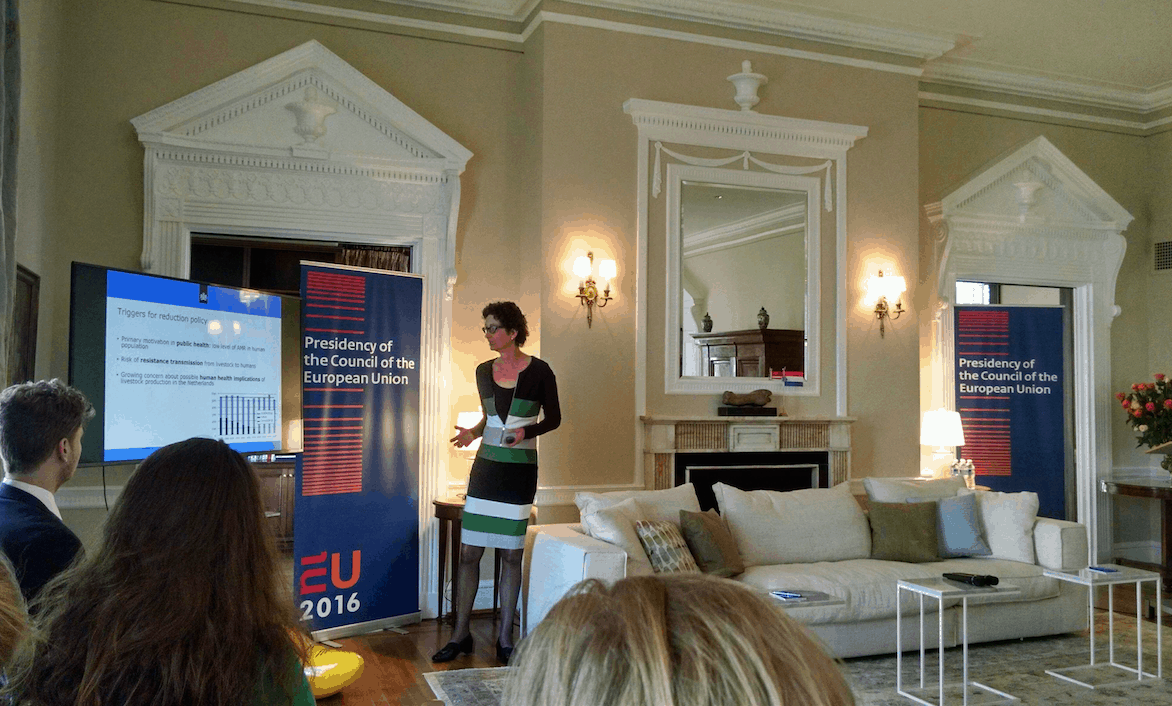April 15, 2016

On Wednesday, April 13, CDDEP joined government officials, researchers, food producers and policy experts at the residence of the Netherlands Ambassador in Washington, D.C. for a seminar entitled “Taking on Antibiotic Resistance: Opportunities to Keep Antibiotics Working for Our Future.” Sessions explored antibiotic use and resistance in the United States and the Netherlands, from how drugs are used and regulated to strategies for appropriate use and data collection, with a special focus on the livestock sector.
Throughout the morning, the discussion touched on areas of agreement and dispute between the two countries. Antibiotic stewardship – reducing overuse and misuse of these drugs – was a chief area of concern. According to Dr. Lauri Hicks, Director of the U.S. Centers for Disease Control and Prevention (CDC) Office of Antibiotic Stewardship, an estimated 30 to 50 percent of antibiotic use in the United States is inappropriate. Hicks and other CDC officials called for specific focus on antibiotic prescribing in outpatient settings, where 80 to 90 percent of U.S. prescribing occurs.
Health officials from both countries also agreed that data and research are essential for combating antibiotic resistance. Some areas of research are well documented, while others – such as the impact of antibiotic use in agriculture on human health – are still vague. However, policymakers in the United States tend to want a scientific consensus before taking action. Dr. Christianne Bruschke, Netherlands Chief Veterinary Officer, warned against this approach, saying, “If we wait until we have all the scientific knowledge, we will be too late.”
By the end of the morning, both presenters and guests were digging into some of the most challenging issues in antibiotic resistance, including environmental surveillance, international data sharing, and making change in low- and middle-income countries. Dr. Peter Davies of the University of Minnesota, who is a voting member of the Presidential Advisory Council on Combating Antibiotic-Resistant Bacteria, challenged attendees to consider how to design and fund environmental surveillance systems, as well as consider potential environmental reservoirs of resistance. Dutch and American officials agreed that little progress has occurred in this area.
Dr. Pilar Ramon-Pardo of the Pan American Health Organization (PAHO) highlighted the challenge of setting up rapid alert systems to share time-sensitive resistance information between countries. Imagine the consequences of a new strain of resistant bacteria that has gone undetected. Bacteria do not respect our borders, so sharing surveillance data between countries is essential to address this impending threat. Dr. Jean Patel, Deputy Director of the CDC’s Office of Antimicrobial Resistance, noted that securing clearance to share health data through official channels can be time consuming, so rapid alert systems should look to informal, peer-to-peer communication.
Finally, participants agreed that discussion and collaboration between the United States and European countries is essential, yet we still need innovative strategies to implement policies, stewardship, and surveillance in low- and middle-income countries (LMICs) where health infrastructure is weaker. In particular, enforcing regulations and making AMR a health priority can be a challenge in LMICs. Nongovernmental alliances such as CDDEP’s Global Antibiotic Resistance Partnership (GARP) and the Global Health Security Agenda aim to increase capacity to target antibiotic resistance in LMICs.
The Netherlands and the United States are vastly different in their size, population, and health and agricultural systems. Still, the two countries find common ground in combating antibiotic resistance and can learn from each other’s successes and failures in this ongoing fight.
Elena Martinez is a CDDEP Research Analyst.
Image courtesy Molly Miller-Petrie.

